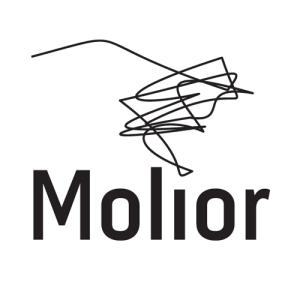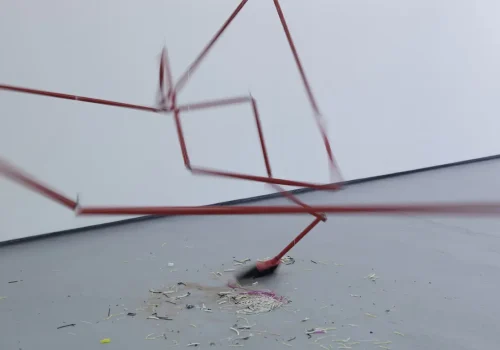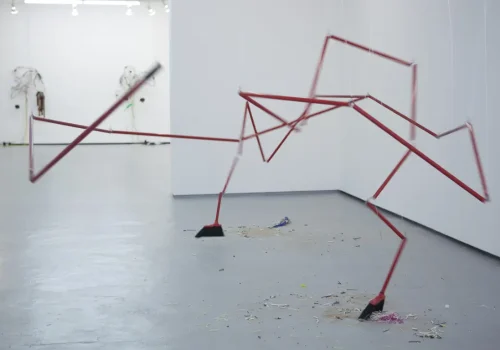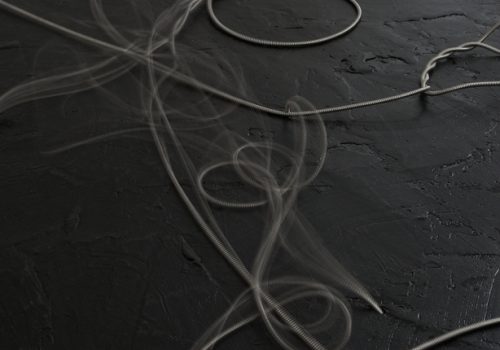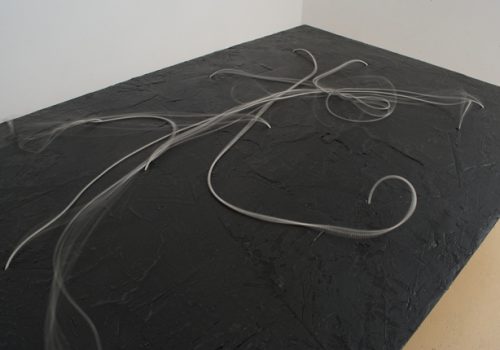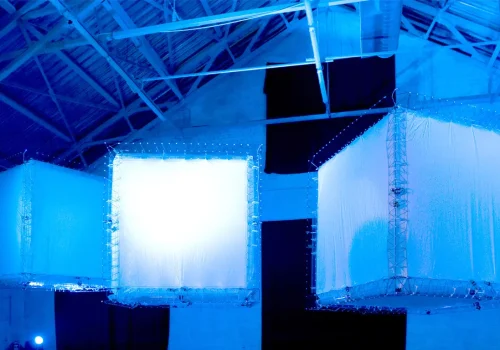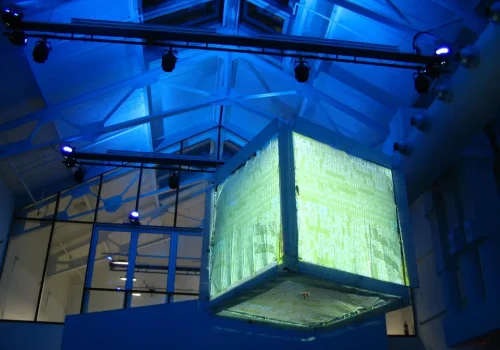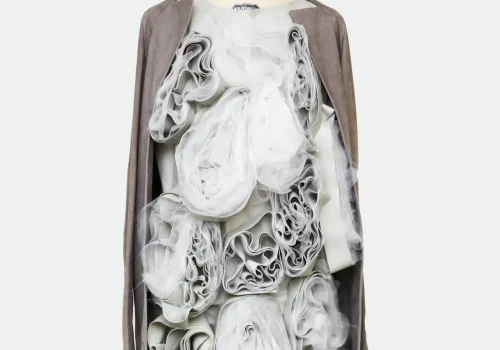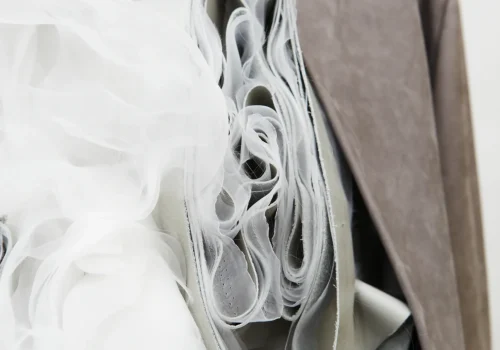FILE - Festival Internacional de Linguagem Eletrônica
Festival FILE
São Paulo, Brazil
From July 16th to August 19th, 2012
The Restless Object
Molior’s participation in FILE 2012 brought four remarkable installations by Quebecois artists who use kinetic technologies to the attention of a Brazilian audience. The works by Ying Gao (linked to the fashion world), Jean-Pierre Gauthier (between visual arts and sound creation) and Nicolas Reeves (close to architecture and design) which are part of FILE 2012 offered a rich overview of current practices in the field of kinetic and robotic art in Quebec.
This selection is representative of a context in which the development of such practices has flourished due to the influence of some renowned Quebecois artists and the solid training Quebecois universities provide in this research and creation area. It is thus that artists such as Bill Vorn, Louis-Philippe Demers or Istvan Kantor, to name but these, have garnered recognition on the international scene with compelling robotic projects throughout the years. These artists have left a stimulating heritage for many and have cleared the path to reflect on (power) relationships between humans and machines. They have also explored psychological dimensions and scenographic elements in their installations and performances, which have had a far reaching impact in the art world.
Nowadays, however, practices in this field are increasingly moving away from the robot aesthetic and anthropocentrism that characterized the trailblazer robotic art projects. Artists have multidimensional relationships with the machine world and they resort to kinetic technologies to explore the numerous aspects of human experience and the surrounding world. As for the movement producing technologies, they turn to digital tools just as well as to more traditional (low tech) means, depending on the projects.
Regardless of the technology’s origin, the choice of movement introduces new behaviours into the material world and opens the possibility of novel effects and meanings. The passage from the static to mobility doubtlessly brings about a major recasting of the object and our understanding of it. Essentially, movement breathes life into inert things and thereby fundamentally questions their identity. In moving, these usually immobile objects begin to take on the characteristics of living organisms. Each of the works brought together for FILE expresses this affinity with the alive in its own way.
As the two interactive Living Pod garments designed by Ying Gao, slowly expand they look to be breathing. Their internal components gently inflate like a rising ribcage. Life seems to have been passed on to the coats by those who had previously worn or made them. The light projected on the coats appears to awaken this link to life, as though by photosynthesis.
Stressato : Samurai Serpents by Jean-Pierre Gauthier is characterized by a very different organic quality. Triggered by approaching visitors, the nervous wriggling of intertwined cables on the table is reminiscent of a defense mechanism against a threat, comparable to that of a hunted animal. As for Sweeping Spirals, by the same artist, the brooms’ disorganized and awkward movement recall an out of control marionette, who having been left to its own devices by an absent master, indecisively and ineffectively tries to carry out its assigned task.
The flying cube of Paradoxal Sleep by NXI GESTATIO (Nicolas Reeves, David St-Onge and Ghislaine Doté), moves slowly and, like the flying machines imagined over the centuries, draws its inspiration from the natural world. It evokes hovering animals or those who navigate using echolocation. The association with a living organization is reinforced by its reactions—before the audience with which it negotiates the space, or in response to voice commands in a performance context.
In these four installations, the presence of everyday objects is palpable. Whether it be Gao’s coats, Gauthier’s table and broom, or Reeves’ cube, they establish an immediate connection with the man-made environment. Like objects encountered in everyday life, they extend human presence in space. What do these common objects tell us when they begin to move in an improbable way?
Among the objects presented in these works, the coats of Living Pod are without a doubt those with the closest connection to intimate space. The garment is worn directly on the skin, it covers and shrouds it. It clearly constitutes an extension and an expression of the self. Removed from the individual who wears it, it still bears a trace of his or her presence. Reanimated by the viewer, these coats seem to claim a life of their own, beyond any bodily attachment.
With their dysfunctional brooms and restless table, Jean-Gauthier’s projects call on a personal and domestic space. Both household chores and drawing generally require a certain diligence. Here, the objects follow their own logic and behave in a disorderly and unpredictable manner. Through their unbridled behaviour, they affirm an identity all of their own.
The NXI GESTATIO flying cube is evidently an object of a more conceptual nature than the others. Primarily a geometric form, the cube is also linked to the architectural domain of which it is a basic element. It belongs as much to mental space as that of the built world, both inner and exterior space, at once private and public. In moving above the ground in a state that oscillates between stationary levitation and mobility, as though suspended in a dream, the cube defies gravity.
These everyday objects, which are part of our intimate, personal and mental spaces, are already human creations; the movement they are endowed with magnifies this human aspect by associating them with life forms. The movement also enables them to exhibit behaviours and actions that are of a theatrical nature. They thus become characters, who while remaining true to their familiar status, reinvent themselves by introducing new dimensions into the viewer’s experience. In all cases, their unexpected behaviours express a desire for autonomy and emancipation from codes. In carrying out their unpredictable and unusual gestures, they defy expectations and invite us to see the known in a new light. As characters, they embody a certain part of who we are and act as a mirror which reflects an altered image of our relationship to the world.
Sylvie Parent
Sylvie Parent
Sylvie Parent is an independent curator and art critic. She has been involved in the visual and digital arts scene for more than 30 years, both in Quebec and abroad. Her exhibitions have been shown in Canada, the United States, Italy, Brazil, China and Taiwan. From 2009 to 2014, she was artistic director of Molior, an organization specialized in the production of exhibitions on the international scene. In the field of publishing, Sylvie Parent acted as editor of magazines such as HorizonZero (2003-2005) and CIAC Electronic Magazine (1997-2000), and contributed to several specialized journals (Parachute, Ciel variable, Espace art actuel, etc.). She is also the author of numerous essays for exhibition catalogues. Sylvie Parent is a recipient of the Joan-Lowndes Award (2017) given by the Canada Council for the Arts to an independent art critic or curator in recognition of the outstanding quality of her work.
Artists & works
Jean-Pierre Gauthier
Sweeping Spirals
2008-2011
Kinetic installation
Broomsticks, strings, motors, motion sensors
Description of the work
Sweeping Spirals is part of series of suspended installations in which geometric forms (Instants angulaires) break up and reassemble in an unpredictable manner. The work is also related to a set of works the artist created around the theme of house cleaning (Remue-ménage and La pause-café du concierge, for example). In Sweeping Spirals, two brooms situated on the opposite ends of a set of interconnected broomsticks take on the shape of a long spiral. Each spiral segment seems to act on its own and the perfect form is only rarely reestablished. In fact, motors pull strings attached to the joints between the segments, creating jerky movements that manipulate them like a big marionette. Moreover, now and then the brooms rub against the floor and push a bit of debris without ever really collecting it. At once tragic and comic, this spiral, which is endlessly disassembling itself and never properly carrying out the task, seems to be engaged in an awkward dance under the viewer’s complicit watch. Involved in an obsessive and inefficient activity that seeks to be useful but fails miserably, the piece nevertheless does function, in terms of its own logic.
Courtesy of Jack Shainman gallery, NY
Biography
Jean-Pierre Gauthier pursues a hybrid approach in which he combines visual art and the musical conception around kinetic and sound installations, invented or automated music instruments.
His installations have been shown in Canada, Europe and Asia. A retrospective of his work was put together at the Musée d’art contemporain de Montréal in 2007 and then travelled throughout North America until 2010. Molior presented several of his works in Sao Paulo, Brazil, notably during the FILE – Festival Internacional de Linguagem Eletrônica in 2012 and as part of Despertar /Éveil/Alive in 2014.
In 2004, Jean-Pierre Gauthier won the Sobey Award for the Arts, and the following year, the Canada Council for the Arts awarded him the Victor Martyn Lynch-Staunton prize. In 2012, Ville de Montréal selected him as the winner of the Prix Louis-Comtois. He his represented by Ellephant in Montreal and Toronto.
The Musée national des beaux-arts du Québec, Musée d’art contemporain de Montréal, Montreal Museum of Fine Arts Musée des beaux-arts and the Art Gallery of Nova Scotia have works by in him in their collections. In 2016, following the acquisition of Orchestre à géométrie variable (2013-2014), the Musée d’art contemporain de Montréal exhibited the work and documented its installation so as to ensure its conservation.
Jean-Pierre Gauthier
Stressato : Samurai Serpents
2010
Kinetic Installation
Stepper motors, metal cables, plywood, silicone, infrared and ultrasound sensors, micro-controllers.
Description of the work
Stressato : Samurai Serpents resembles Jean-Pierre Gauthier’s drawing machines (such as Marqueurs d’incertitude). Like many of the artist’s creations, the work emphasizes graphic quality and the movement of a line in space. On a large panel covered by an “action painting” (that is reminiscent of the textured and dark surfaces of a Borduas, Soulages or Kline), which looks like a (drawing?) table, cables are activated by an approaching viewer and begin to wiggle all over the place, twisting and intertwining in a surprising way—as though they were actually reacting to a threat. In moving about in this way, these silver lines on a black ground continuously change the “painting’s” composition and transform it into an animated image. Like a musical improvisation, the line’s disorganized movements create sounds that vary each time.
C++ Programming: Jason Cook
Biography
Jean-Pierre Gauthier pursues a hybrid approach in which he combines visual art and the musical conception around kinetic and sound installations, invented or automated music instruments.
His installations have been shown in Canada, Europe and Asia. A retrospective of his work was put together at the Musée d’art contemporain de Montréal in 2007 and then travelled throughout North America until 2010. Molior presented several of his works in Sao Paulo, Brazil, notably during the FILE – Festival Internacional de Linguagem Eletrônica in 2012 and as part of Despertar /Éveil/Alive in 2014.
In 2004, Jean-Pierre Gauthier won the Sobey Award for the Arts, and the following year, the Canada Council for the Arts awarded him the Victor Martyn Lynch-Staunton prize. In 2012, Ville de Montréal selected him as the winner of the Prix Louis-Comtois. He his represented by Ellephant in Montreal and Toronto.
The Musée national des beaux-arts du Québec, Musée d’art contemporain de Montréal, Montreal Museum of Fine Arts Musée des beaux-arts and the Art Gallery of Nova Scotia have works by in him in their collections. In 2016, following the acquisition of Orchestre à géométrie variable (2013-2014), the Musée d’art contemporain de Montréal exhibited the work and documented its installation so as to ensure its conservation.
NXI Gestatio (Nicolas Reeves, David St-Onge)
Paradoxal Sleep
2011
Aerobotic installation and performance
Polyurethane bladder, composite structure, ducted fans, on-board computer, LEDs, polycarbonate tubes, ribbon wires, interactive sensors
Description of the work
The Paradoxal Sleep project is part of a series of works in which big robotized cubes, measuring 2,25 m3, serve as floating structures to be used as platforms for various multimedia projects and performances. In the context of FILE 2012, the NXI GESTATIO team will present a single cube that will move in the exhibition spaces. The cube will continually readjust its position by measuring the distance from the surrounding walls. Its sometimes hesitant movements endow it with an organic quality. At regular intervals, the cube will respond to the vocal commands of a performance artist (Ghislaine Doté) and will exhibit particular behaviours. A hybrid choreography will bear witness to the nascent relationship between the two. During the moments not reserved for the performances, it will be the viewer’s turn to engage with the floating cube and the space.
Biography
Nicolas Reeves
Nicolas Reeves studied at Université de Montréal (architecture and physics) and at the Massachusetts Institute of Technology (architecture). In 1995, he founded the NXI GESTATIO laboratory, which is dedicated to research-creation in art, architecture, design and computer science. He was the coordinator of the Artificial Life and Robotic Arts research axis at the Hexagram research and creation institute in media art and technologies, before becoming the scientific director of this institute (2001 – 2008). He was the vice-president of the Society for Arts and Technology from 1998 to 2007. Thanks to his dual training (physics, Université de Montréal, architecture, MIT, 1988) he is able to combine architectural practice, art and design, an extensive use of bioclimatic data, and computer science. He has worked at the Philippe Madec studio (Paris) and for the architect Jacques Rousseau (Montréal) before being admitted to the Ordre des architectes du Québec with distinction. He is continuing his artistic approach in which he questions the foundations underpinning the notions of order, information and organization in relation to time.
David St-Onge
A structural engineer (École Polytechnique) who is also specialized in robotics (MA, Université Laval), David St-Onge completed his studies in view of developing technologies that serve artistic needs. He first worked in set design (theatre, museums and TV) and is now active in the media arts field, among others as part of the interuniversity research and media art centre HexagramCIAM. He has been collaborating with Nicolas Reeves since 2009.
Ghislaine Doté
Originally from the Central African Republic, Ghislaine is a performer, choreographer and composer. Having learned dance, singing and martial arts in Ivory Coast, Ghislaine arrived in Montreal, Canada, with her background of physicality and musicality, which feeds her as a performer and choreographer. Since the end of her bachelor’s degree in dance at the University of Quebec in Montreal in 2002, she has been choreographing and composing her own works. She is artistic director of Virtuo Danse.
Ying Gao
Living Pod
2009
Two interactive coats
Leather, super organza and electronics
Description of the work
The Living Pod project consists of two coats placed on dress form mannequins. The two garments make up a couple in which one is the more “expressive” copy of the other. Actually, when a viewer points a flashlight towards the first garment, it begins to slowly move, while the other imitates these transformations by exaggerating them. As the first coat opens very slightly to allow only a glimpse of its delicate inner fabric, the second unveils an inside comprised of several fabric components which expand and unfold like the petals of a blossoming flower. In unfolding and expanding the fine layers of organza and leather, the garments appear to be breathing. These coats are like characters whose attitudes the viewer may influence. The project invites us to think about the communicative behaviours humans sometimes exhibit.
Robotics designer: Simon Laroche
Biography
Montreal-based fashion designer and professor at UQAM, recipient of the Phyllis-Lambert Design Montréal Grant, Ying Gao questions our assumptions about clothing by combining urban design, architecture and multimedia. She explores the construction of the garment, taking her inspiration from the transformations of the social and urban environment. She is the only fashion designer included by the British magazine Wallpaper in its Canadian Top 40. Recognized worldwide, her designs are frequently shown in museums and galleries. Design is the medium, situated in the technological rather than in the textile realm. Sensory technologies allow garments to become more playful and interactive. Ying Gao explores both the status of the individual, whose physical contours are transformed by external interferences, and the garment’s function as a fragile protective space. Her work testifies to the profound mutation of the world in which we live and carries with it a radical critical dimension that transcends technological experimentation.
